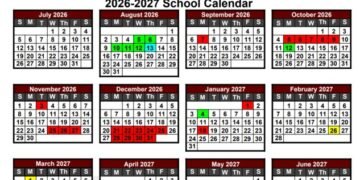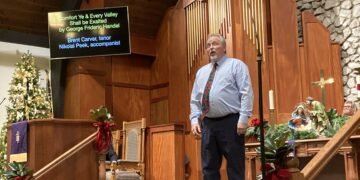County government’s second take on a battery energy storage system zoning ordinance passed muster with the Henderson-Henderson County Joint Planning Commission Tuesday evening.
The joint planning commission voted to recommend Henderson County Fiscal Court to approve the county’s BESS zoning ordinance. The vote was 7-2.
Zoning related to BESS in the county was first heard by the joint planning commission at its June meeting. The planning commission at that time peppered Henderson County Judge-Executive Brad Schneider with questions about that proposed ordinance, including safety precautions and grammatical errors in the document.
At the end of that meeting, Schneider withdrew the proposal and said county government would submit an updated proposal for the planning commission’s review at its July meeting.
The updated proposal, according to Schneider, mirrors the city’s zoning ordinance related to BESS. The planning commission recommended the city’s BESS zoning for approval last fall and the Henderson City Commission approved it in November.
Part of Schneider’s argument hinged on the already-approved zoning for the city. The city’s zoning ordinance for BESS says that a utility battery installation must be located on a parcel zoned heavy industrial and cannot be 100 feet from a residence, among many other regulations.
County residents James Franks and Deirdre McConathy, who were present at both the June and July planning commission meetings, voiced concerns about the proposed ordinance not going far enough to protect residents who live near an installation. McConathy said that a city zoning ordinance doesn’t translate for the county.
Part of that concern deals with fire protection in the county, which is served by volunteer fire departments, unlike the city, and doesn’t have as much water to draw from.
That concern is heightened if a thermal runaway event were to occur at a battery installation. Thermal runways occur when a battery installation overheats and catches fire.
In the June planning commission meeting, Chris Watson, of the Zion Fire Department, told the planning commission that during thermal runaway events lithium-ion batteries can reach temperatures of 1,800 degrees Fahrenheit and sometimes burn for weeks. Spraying water won’t put them out and the fire stops only when the battery runs out of juice, he said.
Watson also said then that the technology surrounding batteries is increasing rapidly, so fast that fire safety codes can’t keep up with the changes. It’s the “unknown hazards” that are worrisome to firefighters who would respond to a thermal energy event, if it were to occur, he said.
Schneider said he believed that the updated proposal does a much better job of addressing safety concerns than the county’s first proposal. For one, both the volunteer fire chief of a district that a battery storage installation plans to locate in and the state codes inspector (amended in the meeting from the state fire marshal) must sign off on the site plan before it can be built.
Additionally, the state fire marshal would need to inspect the installation annually, he said.
Also a part of the proposal is a set of safety guidelines that will be developed by a task force, including officials with volunteer fire departments and the local emergency management office and others that would most likely be used as a template for questioning to officials connected incoming BESS installation so that local officials safety concerns are taken care of before a battery installation gets built, Schneider said.
Additionally, future BESS installations would need to adhere to current and future battery and battery energy storage systems safety standards that the National Fire Protection Association approves, Schneider said. Those standards—NFPA 855 for BESS and NFPA 800 for batteries—have not been adopted and are currently being developed.
Both Franks and McConathy live near a site in which an energy company wants to build a battery energy storage system. Yellowthroat Energy Storage LLC, a subsidiary of Tenaska Energy, has submitted plans to the joint planning commission staff to build a battery installation on a 35-plus acre parcel on Toy-Anthoston Road. The proposed installation abuts two sides of McConathy’s family farm.
McConathy came to the Tuesday planning commission meeting with boxes filled with packets of research she’d conducted since the June planning commission meeting. There were four folders, each with a different subject heading, together totaling hundreds of pages.
The topics of the folders included research involving the proposed ordinance; the Yellowthroat installation which she was told couldn’t be discussed in the meeting because the planning commission was only reviewing a general ordinance and not a specific site; zoning and property values; and risks.
Her main point: take more time and get it right the first time.
“You let the horse out of the barn and it’s awfully hard sometimes to chase it down,” she said, adding she wanted to pin down answers to more of the concerns in the proposed ordinance before its approval.
Through her research, McConathy pointed out several instances that were not mentioned in the county’s current proposal. For example, she said there needs to be some regulation regarding possible perfluoroalkyl and polyfluoroalkyl substances—so-called forever chemicals—that could transfer from the installations and leech into groundwater. She also said the ordinance should contain property value protections and information regarding indemnification.
And she spoke of potential risks that could come from old, leaky underground natural gas pipelines and asked if provisions in the ordinance could mandate set distances from a battery installation to gas pipelines.
“We need to consider all sorts of things that have never been mentioned,” McConathy said. “My asks are that we take time to really develop and think about this because it’s serious. I’d rather take the time to get it right.”
Schneider said regulations are already in place for what can be located near pipelines and federal regulations regarding PFAS are coming.
“I’m sure everybody will be required to adhere (to them),” he said.
He also repeated in a later interview that he was confident in the level of safety the new proposed ordinance calls for and that it allows for a starting point and flexibility to move forward and making changes to it if necessary.
Magistrate Tim Southard, who spoke in favor of the ordinance at Tuesday’s planning commission meeting, said getting an ordinance in place is needed now so that companies can’t locate a battery installation and not be subject to regulation. Others echoed that sentiment during the meeting, including planning commission counsel, Tommy Joe Fridy, who asked McConathy if it wouldn’t be better to get an ordinance in place before companies locate here.
But according to Brian Bishop, the joint planning commission executive director, there are no districts in current county zoning ordinances where a battery installation can locate.
“It is not a listed use (in any of the zoning),” he said.
In the current zoning ordinances, a BESS would need to get a variance of sorts—called a building inspector’s interpretation—that would come from the county codes administrator, he said. Short of that, a company could file an appeal to the county Board of Zoning Adjustments, and if that was rejected, appeal to the Henderson Circuit Court, he said.
So, in fact, under current county zoning ordinances, a company wanting to bring a BESS would need to jump through hoops that won’t be in place when and if the zoning ordinance proposal gets approved.
With the proposal’s safety and a task force to write safety guidelines–and a similar city ordinance already in place–Schneider said he didn’t want to put the ordinance on pause and develop it further.
“I didn’t think there was any reason to wait,” he said.
McConathy lamented that her farm “is going away by no choice of my own.”
“Be careful because when it’s gone, it’s gone,” she said.
Schneider said Fiscal Court will hear a first reading of the zoning ordinance after planning commission staff can transcribe the public hearing from Tuesday’s meeting and send documents related to the proposed ordinance. He said a first reading could probably occur next month.


















